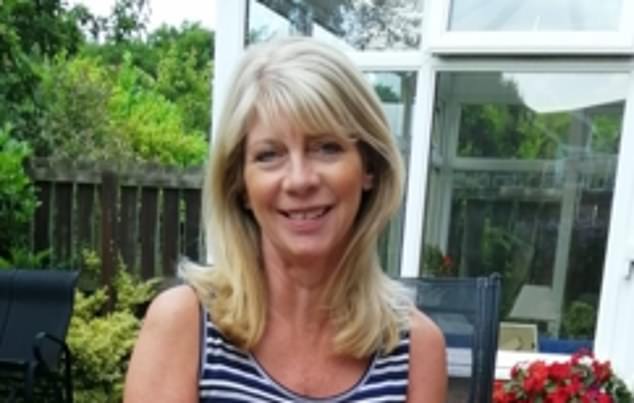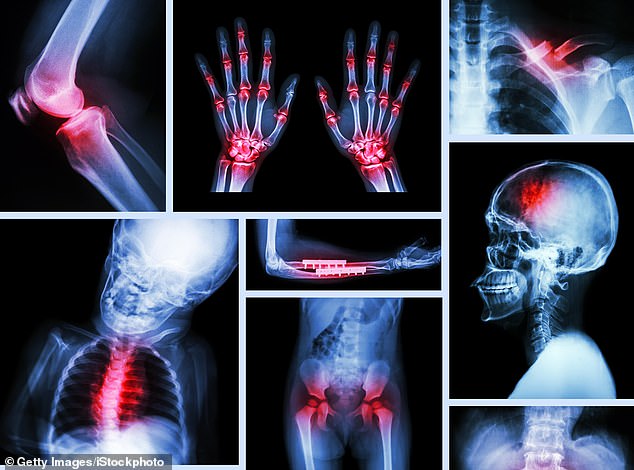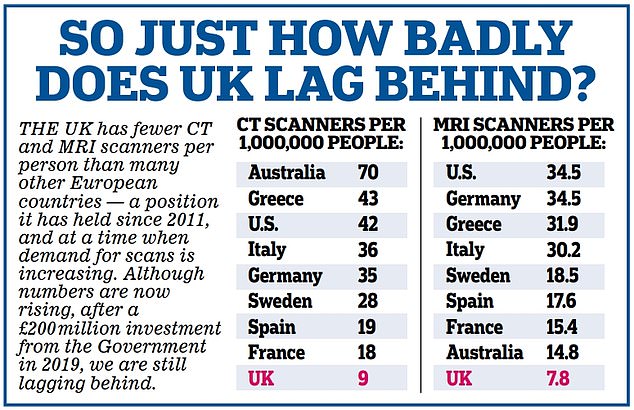Arriving at A&E in the middle of the night in January, Marion Herron feared she’d be stuck in hospital for days.
The 54-year-old had started feeling unwell — with slurred speech, a headache, ringing ears and loss of balance — just an hour or so earlier, while watching TV with her husband Alan. Realising something was seriously wrong, he called an ambulance.
With coronavirus restrictions in place, Alan, 57, a retired policeman, couldn’t go with Marion to hospital and she feared she’d be stranded there, alone.
‘I remember thinking, “Will I ever come back?”,’ says Marion, a mobile hairdresser from Ashington, Northumberland.
But the hospital where she was taken had a new approach to scans, which meant that Marion was diagnosed, treated and home again within a matter of hours.

Arriving at A&E in the middle of the night in January, Marion Herron feared she’d be stuck in hospital for days
The scheme at Northumbria Healthcare NHS Foundation Trust sounds simple enough: emergency patients get their own dedicated imaging equipment to ensure fast access to ultrasound, CT and MRI scans.
Since the scheme’s introduction six years ago, waiting times for scans have halved and the length of hospital stays has dropped by a third among emergency patients, freeing up beds to treat others.
Scans are the gateway to NHS medical care, and are pivotal to its smooth running.
They range from simple X-rays and ultrasound, to high-tech computerised tomography (CT, where multiple X-rays are used to produce a more detailed image) and magnetic resonance imaging (MRI, where magnetic fields and radiowaves generate images of organs in the body), and play a key part across the whole care process.
Without scans, a patient has symptoms, not a diagnosis. But as well as diagnosing conditions ranging from cancer and stroke to heart disease, infections and broken bones, scans are needed to plan and carry out treatments, and to monitor patients to see if those treatments are working.
Scans are also vital for discharging patients from hospital or from their treatment.
Now, as the NHS faces a watershed moment — with waiting lists at a record 5.3 million in England alone as a result of delays caused by the Covid-19 pandemic — ramping up access to scans is being hailed by experts as key to getting the NHS back on its feet.
However, there are very real concerns that the patchy and sometimes woeful lack of scanning provision will undermine attempts to clear the backlog.
Marion’s experience highlights what a difference improved access to scans can make, benefiting both the patient and the NHS.

Without scans, a patient has symptoms, not a diagnosis. But as well as diagnosing conditions ranging from cancer and stroke to heart disease, infections and broken bones, scans are needed to plan and carry out treatments, and to monitor patients to see if those treatments are working
Within two hours of arriving at A&E, with its dedicated scanning unit, Marion had undergone a CT scan of her brain.
These results were inconclusive and doctors thought the problems may be related to multiple sclerosis, which Marion was diagnosed with 12 years ago.
So at 10.30am the next day, she underwent a more detailed MRI scan, which revealed a clot on both sides of her brain — a haemorrhagic stroke — for which she received blood thinners and cholesterol-lowering tablets.
With the right diagnosis and treatment, she was sent home just 16 hours after being admitted.
In other hospitals this process can take days.
‘It’s a shock to have a stroke at my age, when I am generally fit and healthy, but the care I received couldn’t have been better,’ says Marion.
‘I was home the next day having had a full MoT. It was a relief what with everything that was going on with the virus.’
Number of scans plummeted
Like all aspects of routine medical care, access to scans has fallen dramatically during the pandemic, as NHS hospitals have been focusing on Covid patients.
Between March and December last year, 11 million fewer scans were carried out in England compared with the same period in 2019, a drop of 28 per cent, according to an analysis by the Royal College of Radiologists.
An estimated one in three people missed out on a scan they should have had.
This meant, at the end of May, 854,868 patients were waiting for a CT, MRI or ultrasound scan, with one in six waiting longer than six weeks, the national target from referral to scan. That’s a six-fold increase compared with 2019.
Increasing the use of scanning machines through schemes such as the one at the Northumbria Trust would not only clear the backlog but could be key to reducing NHS waiting lists for routine hospital treatments such as joint replacements and hernia repairs, say doctors.
‘Improving patient access to imaging by increasing capacity has the potential to bring about real improvements to patient care and cut waiting times, which have increased dramatically during the pandemic,’ Dr Jeanette Dickson, president of the Royal College of Radiologists, told Good Health.
‘Imaging is critical to modern healthcare — quick, accurate scans mean patients get the right diagnoses and care pathways, meaning faster, better treatment, quicker discharge from hospital and efficiency savings for the NHS.’
Pre-pandemic, some hospitals, such as Northumbria Healthcare NHS Foundation Trust, had identified early on how crucial it is to improve scanning access — with impressive results.
In 2015, it introduced its separate scanning service for emergency patients, available 24/7 — halving the time emergency patients had to wait for scans from three days to less than 1.5 days, and reducing hospital stays for these patients from 5.1 days to 3.5 days in 2019/2020, freeing up beds for other patients.
In addition, the scheme has led to a more reliable service for outpatients and routine patients in the hospital, because they no longer face delays if an emergency comes in.
‘Previously, like most hospitals, all emergency and routine patients shared the same imaging machines,’ says Dr Rahul Dharmadhikari, a consultant radiologist and unit director at Northumbria Healthcare NHS Foundation Trust.
‘Outpatients would have planned appointments and we would fit emergency patients in between them, but this would lead to delays for both groups.
‘We have made huge, huge gains by separating the scanning of emergency and routine patients in terms of cost, by reducing hospital stays, and treating more patients.
‘We are also providing faster treatment to patients and, in many cases, better treatment because it is given earlier. Most urgent patients now have their scans and results on the same day, which means doctors can take immediate action.
‘This approach has helped to improve the flow of emergency patients during the pandemic, which in turn has a positive impact on services across the hospital.’

As the NHS faces a watershed moment — with waiting lists at a record 5.3 million in England alone as a result of delays caused by the Covid-19 pandemic — ramping up access to scans is being hailed by experts as key to getting the NHS back on its feet
Why seven day access helps
While the Northumbria Trust started offering the scanning service when it opened a new emergency hospital with a purpose-built scanning building, Dr Dharmadhikari says other hospitals could introduce similar systems into their current sites.
‘It can be done with planning and understanding of the processes,’ he says. ‘If these measures can be rolled out nationally it would make a huge difference to the quality of care offered by the NHS. With the challenges facing the NHS, improving access to scanning services is a no-brainer.’
Other hospitals are finding different ways to boost scanning capacity. Doncaster and Bassetlaw Teaching Hospitals NHS Trust has increased the number of patients treated by streamlining the number of images taken during each scan.
It had already extended scanning times from 8am to 8pm, seven days a week, but in late 2019 it was still struggling to meet the Government’s six-week target from referral to scan.
‘With MRI referrals and waiting times increasing, we decided to look at neighbouring trusts to see how they got through so many more scans,’ explains Sara Elliott, head of radiology services.
‘We discovered that they took fewer images for certain procedures such as shoulder, wrist and elbow MRIs, while maintaining the same imaging quality.
‘By adopting this approach, we were able to reduce the time it takes to carry out a scan by ten minutes, which saved us a total of 97 hours of scanning time a month, allowing us to treat hundreds more patients.’
Following a similar review for strokes, the hospital has reduced this scan time by ten minutes, too, without altering the patient outcome, their research shows.
‘This has allowed the hospital to double the number of patients scanned in dedicated stroke slots, so now more patients are seen more quickly,’ adds Sara.
Another solution to boost scanning availability is to train more junior clinical staff, such as radiology department assistants (RDAs), to check that patients are having the right scan when they need it. Typically this vetting is done by sonographers and radiologists, taking up a significant amount of their time.
RDAs now carry out 39 per cent of these checks at the Queen Victoria Hospital NHS Foundation Trust in West Sussex, freeing up doctors to do more complex procedures, Dr Ian Francis, a consultant radiologist and associate medical director at the Trust, told Good Health.
‘These assistants can also help with biopsies, rather than doctors grabbing a colleague to help them out on an ad-hoc basis as used to happen,’ says Dr Francis.
‘For 80 per cent of patients we now offer a one-stop shop, where, for example, they might have an MRI to make a diagnosis and then the same day an ultrasound and a biopsy — and RDAs are critical for that.’
Waits for scans and results
These hospitals are among only a handful to have taken such actions to improve scanning capacity. Yet, even before Covid and the long NHS waiting lists it has created, there was a pressing need to increase the number of scans taken.
The NHS in England normally performs around 45 million scans a year — including around 23 million X-rays, six million CT scans, 3.8 million MRI scans and around ten million ultrasound scans.
This in an increase of more than 25 per cent in the past five years as patient numbers have risen and technological advances mean that sophisticated MRI and CT scans can perform an increasing number of tasks, such as image-guided surgery (for example, to place stents to keep narrowed arteries open).
Yet two new NHS reports, published in October and November last year, found huge variations in the services offered by hospitals.
Even pre-pandemic, more than half of routine patients referred for an MRI or ultrasound waited more than 14 days for the scan, while one in six waited six weeks or longer.
Many patients then have to wait again for weeks or even months to get their results (and diagnoses), even though ideally they’d receive their scan results before they leave hospital. Around one in five patients has to wait two weeks for MRI results, and one in 20 patients waits more than a month. Both reports blamed this on a range of factors, including lack of equipment and staffing shortages.
Earlier this year, the Royal College of Radiologists estimated that there’s a shortfall of nearly 2,000 radiologists (the doctors who analyse scans) in England, along with shortages in sonographers (who specialise in ultrasounds) and radiographers (who operate the scanning equipment).
Indeed, in some hospitals, scanning machines are sitting idle simply because there aren’t enough staff to operate them.
There are also ‘substantial variations’ in the distribution of machines among the 152 trusts in England that provide radiology services, according to one of the reports, by the Getting It Right First Time (GIRFT) programme.
For example, while one trust has 70 X-ray machines, more than 20 trusts have fewer than ten each. Some trusts have just one CT scanner while another has 26, and more than 25 trusts have only one MRI scanner, and others have nine.
‘Radiology is a way into almost every speciality in the NHS; patients don’t present with cancer, they come with symptoms that need to be diagnosed, and that is done by performing a scan and interpreting the results so that doctors can come up with a treatment plan,’ says Dr Kath Halliday, a consultant radiologist at Nottingham University Hospitals NHS Trust, who spent more than two years reviewing the 152 radiology departments for this report.
‘The shortcomings we uncovered mean diagnoses are not delivered as quickly as they could be and that prevents the NHS from working as efficiently as it can. Earlier diagnoses increase the chance of successful treatment and save the NHS money.’
The GIRFT report found another problem is outdated IT. While hospitals rely on computer systems to function, fewer than 30 per cent of trusts have 24/7 technical support for radiology departments and many struggle to meet ‘minimum IT requirements’.
The report made 20 recommendations, including having dedicated urgent and non-urgent machines for emergency and routine patients, training junior staff to take on new roles such as triaging, as the Queen Victoria Hospital NHS Trust in West Sussex has done, and extended hours for outpatient appointments, including weekends and longer days.
We also need specialist hubs
It also called for a new national target to be phased in — from the scan time to when the patient receives their results — to reduce the time some patients have to wait for a diagnosis.
If hospitals take all these recommendations on board, it will ‘unlock substantial improvement’ even with the resources we have, said the GIRFT report.
Another longer-term step is to create community hubs, away from hospitals, to perform scans and tests on non-urgent patients, preferably on the same day — according to the second NHS report, written by the former cancer tsar Professor Sir Mike Richards.
Ideally, these should operate ‘14 hours a day, seven days a week’, he says, although staff shortages mean this is ‘unachievable in the short term’.
His report called for CT scanning capacity to be doubled over the next five years to keep up with demand and bring the UK in line with other countries (see box, left). In total, the NHS in England has around 3,000 X-ray machines, 516 CT scanners and 425 MRI scanners.
Just to bring the UK up to the average number of MRI and CT scanners among the G7 and EU countries would cost around £1.5 billion, the Health Foundation, an independent healthcare charity, calculated in 2019.
‘Before the pandemic, the need for radical improvement in diagnostic services was already clear cut,’ Sir Mike Richards said in his report. ‘Diagnostic services in the NHS were reaching a tipping point. Major expansion must start as soon as possible.’
Dr Jeanette Dickson adds: ‘We have been warning for years that radiology is a chronically under-resourced service in the NHS. Demand for services has increased at a higher-than-expected rate owing to technological advances.
‘While this makes imaging more accurate and useful for diagnosing and treating all sorts of injuries and conditions, it has not been matched with enough staff, scanners and updated ways of working. This has to change.’
Source link : https://www.dailymail.co.uk/health/article-9853339/Shortage-scan-equipment-means-facing-fresh-crisis.html











